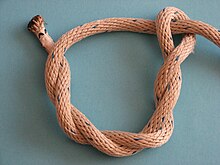Timber hitch
| Timber hitch | |
|---|---|
 |
|
| Names | Timber hitch, Bowyer's Knot, Lumberman's Knot, Countryman's Knot |
| Category | Hitch |
| Related | Killick hitch |
| Releasing | Non-jamming |
| ABoK | #195, #479, #1665, #2161 |
| Instructions | [1] |
The timber hitch is a knot used to attach a single length of rope to a cylindrical object. Secure while tension is maintained, it is easily untied even after heavy loading.
The timber hitch is a very old knot. It is first known to have been mentioned in a nautical source c. 1625 and illustrated in 1762.
As the name suggests, this knot is often used by lumbermen and arborists for attaching ropes to tree trunks, branches, and logs. For stability when towing or lowering long items, the addition of a half-hitch in front of the timber hitch creates a timber hitch and a half hitch, or known as a killick hitch when at sea. A killick is "a small anchor or weight for mooring a boat, sometimes consisting of a stone secured by pieces of wood". This can also prevent the timber hitch from rolling.
This knot is also known as the Bowyer's Knot, as it is used to attach the lower end of the bowstring to the bottom limb on an English longbow.
The hitch is also one of the methods used to connect ukulele and classical guitar strings to the bridge of the instruments.
Timber hitch on a tree trunk.
Timber hitches on the bridge of a classical guitar
To make the knot, pass the rope completely around the object. Pass the running end around the standing part, then through the loop just formed. Make three or more turns (or twists) around the working part. Pull on the standing part to tighten around the object.
A common error in tying can be avoided by assuring that the turns are made in the working part around itself. When making the hitch in laid rope, the turns should be made with the lay of the rope, that is, in the same direction as the twist of the rope.
Timber hitch step by step. Three turns are shown.
Tying technique for stringed instruments
Although The Ashley Book of Knots states that "three tucks or turns are ample", this work was written prior to the wide use of synthetic fiber cordage. Later sources suggest five or more turns may be required for full security in modern ropes.
...
Wikipedia
